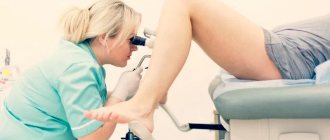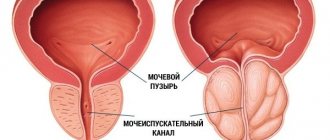A clinical sign manifested as a burning sensation in the penis is a common phenomenon in males.
Often men try to ignore this symptom, believing that the burning sensation will go away on its own.
There are not many reasons why a burning sensation in the penis may develop.
However, they are usually divided into two broad groups - non-communicable diseases and infectious diseases.
Clinical signs are dictated by the underlying pathological process.
A burning sensation in the penis is not often the only symptom.
It may be accompanied by redness of the prepuce, testicles, soreness, and rashes on the surface of the penis.
Itching or burning in the genital area usually indicates a sexually transmitted disease.
A burning sensation in the penis occurs with various types of STDs - herpes, gonorrhea, Trichomonas, etc. and may occur in combination with other symptoms.
Burning and itching rarely go away on their own and require medical treatment.
A urologist or venereologist will be able to find out the cause of these symptoms and make an accurate diagnosis after the diagnostic measures that the patient undergoes.
Burning sensation in the penis due to candidiasis (causative agent Candida albicans)
Candidiasis or thrush is a common cause of burning sensation in the penis and other unpleasant symptoms.
Fungal infection in men is less common than in female patients, which is explained by the difference in the structure of the urogenital tract.
However, symptoms of candidiasis can also occur in the male genital area.
It is especially important to quickly recognize the disease and prevent its progression.
The growth of Candida albicans increases sharply under certain conditions, which leads to the development of the disease
For example, with a weakened immune system, concomitant STIs, or lack of normal genital hygiene.
In addition, narrowing of the foreskin of the penis is often a provoking factor in the development of candidiasis.
According to studies, the circumcision procedure (circumcision) reduces the risk of developing candidiasis in men by almost 30%.
Symptoms of candidiasis often include the following: itching, redness, burning of the glans penis, swelling of the foreskin.
Other symptoms of candidiasis include painful urination, abnormal discharge from the urethral canal, and pain may occur during sexual intercourse.
The main complaint of patients is a constant burning sensation of the penis.
Candidiasis is also associated with the appearance of an unpleasant odor and white deposits that appear under the foreskin.
It is possible to develop rashes that resemble small blisters and a burning sensation in the penis after sex.
If the fungal infection progresses, there is a chance that it will trigger a fever due to the inflammatory process.
Symptoms of candidiasis may occur all at once or appear gradually.
Thrush is not a typical STI or sexually transmitted disease, but, nevertheless, it is successfully transmitted through sexual contact.
The doctor will tell you the treatment regimen and what exactly to treat after a thorough examination.
Candida albicans must be treated with antifungal drugs; oral and topical agents can be prescribed in the form of ointments/creams.
Antifungal agents inhibit the growth of the pathogen and prevent its further development.
They contain certain active ingredients such as imidazole, povidone-iodine or nystatin.
They are highly effective substances against yeast-like fungi.
Ointments or creams should be used regularly, applied in a thin layer to the affected areas of the genital organ.
Until the infection is stopped.
If signs of fungus are pronounced, antifungal agents in tablet form are additionally prescribed.
At the end of antifungal therapy, it will be necessary to restore the microflora of the intestines and genitourinary system using drugs based on lactobacilli.
During the treatment period, sexual intercourse should occur exclusively with the use of a condom.
And it is best to exclude them until recovery.
Using condoms during intimacy is an effective prevention method.
It is also necessary to monitor the state of the immune system.
Do not use antibiotics without a doctor’s prescription and regularly perform genital hygiene.
Treatment
Treatment of urological problems is a long and scrupulous process. In most cases, only a set of measures can help.
We use methods such as:
- drug treatment;
- physical therapy;
- prostate massage;
- treatment with active oxygen (ozone therapy);
- mud therapy (Dead Sea mud);
- medical and medicinal droppers;
- adjusting the patient’s lifestyle and nutrition;
- development of an individual prevention program;
- monitoring the patient's condition after treatment.
Trichomoniasis and burning sensation in the penis
Trichomoniasis is an infection caused by Trichomonas vaginalis.
May be found in the urethra, bladder, vagina, cervix or under the foreskin of the penis.
Trichomoniasis is more common in people with multiple sexual partners.
It can be transmitted through unprotected sexual activity.
Including mutual masturbation and sharing sex toys.
In men, symptoms of trichomoniasis may include:
- pain during urination and ejaculation
- itching, burning sensation in the penis
- redness of the head
- swelling
- slight discomfort during intercourse
In the morning, pathological discharge from the urethral canal may be observed.
According to studies conducted by the Centers for Disease Control and Prevention, only 30% of patients report developing any symptoms.
This means that in 70% of cases people do not experience any symptoms.
Or the signs are so mild that they go unnoticed.
It is important to start treatment of trichomoniasis in time and effectively eliminate the burning sensation in the urethral canal of the penis.
Since a long-term infection can cause a number of complications from the genitourinary system:
- Prostatitis (inflammation of the prostate gland, transition of the pathology to a chronic form)
- Epididymitis (inflammation of the epididymis (epididymis))
- Orchitis (swelling due to an inflammatory reaction of one or both testicles)
The disease increases the body's susceptibility to HIV infection.
Increases the risk of developing prostate cancer and can cause infertility.
Trichomoniasis is considered one of the simplest sexually transmitted pathologies.
It is quite easy to treat with antiprotozoal drugs.
The infection is treated either as a single dose or in smaller doses taken over 5 days.
Important! Both sexual partners must complete the full course of therapy and abstain from sexual contact until treatment is completed. Be sure to take follow-up tests after treatment.
Why is this happening?
There is evidence that risk factors for compression of the pudendal nerve are:
- Chronic microtraumas (non-systematic exercise according to the principle: “it’s better rarely, but wear it out.” This includes cycling, exercise in the gym, team sports).
- Hormonal disorders (diabetes mellitus, hypothyroidism, etc.)
- Systemic connective tissue diseases (collagenosis, etc.)
- Chronic intoxication (alcohol)
- Genetic predisposition
- Congenital anatomical features of the pelvis
Burning sensation in the penis due to gonorrhea
Gonorrhea, also known as "gonorrhea".
It is a common STI among men, particularly gay and bisexual men.
The causative agents of the pathology are gonococci.
These are gram-negative, paired microorganisms that can cause infections in the urethra, anus and/or throat mucosa.
In men, gonorrhea first appears as urethritis.
Urethritis is expressed by the discharge of yellow-greenish pus (often in the morning), painful urination, and a slight increase in body temperature.
Many patients note a burning sensation in the penis after anal or vaginal sex.
When the pathogen rises higher up the urethra, inflammation of the epididymis and prostate may occur.
Subsequently, occlusion of the seminiferous tubules of the epididymis develops, which leads to infertility.
Gonococci, the causative agents of gonorrhea, can spread through the bloodstream throughout the body.
At the same time, causing secondary diseases such as joint inflammation, tendinitis, conjunctivitis, eye irritation or dermatitis.
There may be no symptoms.
Therefore, the only way for a person who has been exposed to gonorrhea to determine whether they are infected is to undergo laboratory testing.
Gonorrhea can be diagnosed using a urine test or swabs taken from the urethra, anus, and throat mucosa.
Gonorrhea is often accompanied by chlamydia.
Therefore, it is recommended to take a comprehensive test for STIs, and not for individual sexually transmitted diseases
In uncomplicated cases, the usual treatment is a single dose of a medicine such as Ceftriaxone given intramuscularly or Cefixime.
Additionally, a single dose of Azithromycin tablet is prescribed.
These are effective antibiotics and fast-acting drugs, but may cause some side effects from the gastrointestinal tract.
In some cases, after gonorrhea is treated, symptoms may remain for some time.
As a rule, this phenomenon is accompanied by postgonococcal urethritis.
This condition is usually caused by chlamydia that has not responded to antibiotic therapy.
In this case, an additional antibiotic is prescribed aimed at destroying Chlamydia trachomatis.
Chlamydia and burning sensation in the penis
Chlamydia in men is mainly transmitted during unprotected sex - if the sexual partner is already infected.
Sharing sex toys also contributes to chlamydia infections.
All sexual practices in which there is direct contact between the mucous membranes of a healthy person and an infected person are dangerous.
The largest amount of the infectious agent is found in the ejaculate and vaginal secretions.
If left untreated, Chlamydia trachomatis pathogens can spread to the prostate, vas deferens, testes, and epididymis.
This can lead to severe inflammation and sometimes infertility.
Chlamydia in men rarely manifests itself with a pronounced clinical picture, so it often goes unnoticed and untreated.
However, if the symptoms develop, they are quite pronounced: redness of the head of the penis, burning as a symptom of urethritis, painful urination.
Common signs of infection include itching and watery or purulent discharge from the urethra.
Men infected with chlamydia often experience inflammation of the urethra, which is accompanied by pain and fever.
Chlamydia trachomatis is characterized by disappearance of symptoms without treatment, however, this does not mean that the patient is completely healthy.
Organ injury
Soreness can be caused by the fact that a person has too intense sex life or masturbates. At the same time, the penis can hurt even if you simply touch it when visiting the toilet.
Pain also occurs due to the fact that the partner does not have enough discharge during intimacy and insertion of the penis is difficult. To reduce the risk of injury to the organ, for example, to avoid rupture of the frenulum, you need to use lubricant.
Injuries can be thermal - getting a burn, frostbite of the penis. Such accidents should not be ignored or treated at home. You definitely need to go to a surgeon.
Among mechanical injuries, head contusions are common. In this case, the pain is severe, the organ swells, there are bruises on it, and obvious difficulties arise when using the toilet. A urologist together with a surgeon will help.
Soreness can be caused by urolithiasis, a tumor after incorrect circumcision, or due to priapism. The latter pathology is manifested by an incessant erection.
Only medical assistance will help minimize the consequences. If you have pain, you need to go to the doctor.
What tests should I take if I suspect chlamydia?
Chlamydia trachomatis has some complications because the pathogen is intracellular.
It is difficult to culture and serological tests will not provide meaningful results.
Thus, chlamydia culture and ELISA will indicate the presence of chlamydia with an accuracy of only 60-70%.
The only informative method that can detect infection with 100% accuracy is PCR.
Chlamydia in men can be effectively treated with antibiotics.
The most common treatment consists of Azithromycin therapy.
Patients who have been infected through anal intercourse are prescribed Doxycycline.
The drugs are taken daily for 5-7 days.
Possible side effects of treatment: nausea, abdominal pain, diarrhea.
In case of infection with chlamydia, treatment is also prescribed to the sexual partner.
During the entire course of therapy, it is recommended to abstain from intimacy.
What is the most effective prevention of chlamydia?
There is only one truly effective preventive measure.
This includes regular condom use and annual STI testing.
Diagnostics
Patients with inflammatory diseases are examined by a urologist-andrologist. If signs of STIs and dermatological pathologies are detected, patients are referred to a dermatovenerologist. Determining the nature of the disease is based on complaints, objective examination data and laboratory tests:
- Questioning, inspection.
During the conversation, the moment of symptom onset, the presence of other manifestations, and the dynamics of their development over time are clarified. In inflammation, identifying the causative factor plays a significant role. During examination, the doctor identifies swelling, hyperemia, erosion, rashes and other changes, assesses their localization and prevalence. - Lab tests.
Microscopy is performed to confirm inflammation. To clarify the nature of the pathogen, PCR and inoculation on nutrient media are performed. If scabies is suspected, a scraping examination is performed. For dermatitis, a general blood test is prescribed to confirm eosinophilia, the concentration of immunoglobulins is determined, and allergy tests are performed.
If there are indications, consultations with doctors of various profiles are prescribed to identify provoking pathologies. Patients can be referred to an endocrinologist, therapist, phthisiatrician, and other specialists.
Burning sensation in the penis due to urethritis
Urethritis is an inflammation of the mucous membrane of the urethra.
Most cases of the disease are associated with bacterial infections.
Such as Neisseria gonorrhoeae, Chlamydia trachomatis, Mycoplasma genitalium, Trichomonas vaginalis and Ureaplasma urealyticum.
Less commonly, urethritis develops against the background of a viral pathology or an allergic reaction.
In addition, the inflammatory reaction of the mucous membrane of the urethral canal may be a consequence of the nonspecific influence of microflora of a conditionally pathogenic nature.
Urethritis may be associated with the following diseases:
- cystitis
- epididymitis
- orchitis
- prostatitis
- proctitis
- Reiter's syndrome
In men, the symptoms of urethritis are more pronounced due to the greater length of the urethra.
The following signs are characteristic of inflammation of the urethra:
- The appearance of a small amount of blood in the urine or semen
- Burning sensation in the head of the penis
- Painful ejaculation
- Pathological discharge from the penis
- Burning sensation in the penis after urination and during deurination
- Inflammation and redness of the foreskin
- Burning sensation in the penis after sex or masturbation
- Enlarged lymph nodes in the groin area
- Fever, chills, increased temperature, but this is rare
In approximately 25% of cases, urethritis does not cause any symptoms and remains completely invisible to the man.
The symptoms of urethritis are not much different from the symptoms of cystitis; both diseases are related to lower urinary tract infections.
Diagnosis of urethritis consists of examining blood, urine and a smear from the urethral canal.
Testing for STDs is mandatory.
Treatment for urethritis will depend on the cause of its development.
Bacterial urethritis is treated with antibiotics.
Here the first choice is macrolides, such as Azithromycin, Macropen and fluoroquinolones - Levofloxacin, Ciprofloxacin.
Possible complications for men include infection in the bladder, testicles, or prostate gland.
Some tips for prevention
Itching in the anus and urethra with prostatitis is associated with a decrease in local immunity. To avoid this, you need to promptly treat prostate inflammation. During the treatment of prostatitis, the following will help prevent the occurrence of itching in the anus:
- balanced diet, fermented milk products in the diet;
- wearing underwear made of natural fabric;
- proper hygiene of the genitals and anus;
- prevention of constipation;
- moderate physical activity.
Avoid using soaps containing chemical fragrances and dyes. For genital hygiene, it is better to use only water. To avoid imbalance of the microflora of the rectum, you should eat right, avoid constipation and prolonged sedentary work.
Related Articles
Sex with prostatitis – benefit or harm?
Anal orgasm in men: how to get it, doctors' opinion, precautions
Methyluracil suppositories for prostatitis: the effect of the drug, reviews from men
Red spots on the penis and head: causes and methods of combating
How to reduce libido in women: ways to combat hypersexuality
Tinctures for prostatitis: the most effective recipes for fighting the disease
Balanoposthitis and burning sensation in the penis
Inflammation of the glans penis has both infectious and non-infectious causes.
Inadequate hygiene is the most common cause of nonspecific acute balanoposthitis.
Typically occurs in boys between 2 and 5 years of age.
Other causes include: trauma from masturbation, allergic reactions, irritation from detergents.
Clinical features of nonspecific acute balanoposthitis include pain, redness, and a burning sensation under the head of the penis.
With balanoposthitis, a man often complains of a burning sensation in the penis after sexual intercourse or during urination.
It is worth noting that balanoposthitis, as a rule, occurs with the development of a burning sensation in the penis, but without pathological discharge.
The doctor determines balanoposthitis based on the results of microbiological studies of urine and a smear from the urethral canal.
Depending on the cause, the doctor may recommend the following therapeutic measures:
- Antifungal ointment if Candida is the cause of the disease
- Oral antibiotics if balanoposthitis is associated with a sexually transmitted infection
- Mild corticosteroids (ointment) when the condition is associated with an allergic reaction or irritation
- Circumcision if multiple relapses and concomitant phimosis are observed
The following recommendations may help prevent some cases of balanoposthitis:
- Wash the head of your penis thoroughly every day
- In case of balanoposthitis associated with condom use, try using condoms specifically for sensitive skin
- Wash your hands before urinating, especially if you come into contact with chemicals
- Always use a condom during sex, especially with a new sex partner
Burning sensation in the penis as a symptom of prostatitis
Prostatitis is an inflammation that affects the prostate gland.
There are two types of prostatitis: acute (bacterial, non-bacterial) and chronic.
Acute bacterial prostatitis is most often caused by E.coli, Klebsiella and Proteus bacteria, various viruses, fungi, and STIs.
Chronic bacterial prostatitis is also a consequence of the pathogens described above.
In both cases, the clinical picture is similar, patients note the following symptoms:
- Cutting, burning in the penis, feeling of tension or heaviness in the perineum
- Significant increase in frequency of urination
- Feeling of incomplete emptying of the bladder (desire to repeat deurination after a few minutes)
- Dysuria (difficulty urinating)
- Pain in the testicles and groin area
- Low sexual desire, erectile disorders
- Dyspareunia (painful intercourse)
- Premature or even painful ejaculation
The treatment recommended by your doctor will depend on the type of prostatitis.
Bacterial inflammation is treated with antibiotics and NSAIDs.
Non-infectious prostatitis, which is often associated with congestive processes in the pelvis, requires a change in the patient’s lifestyle.









